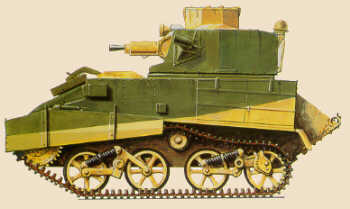![]()
Royal Scots Dragoon Guards
Light Tank Mk VI

| GENERAL DATA | |||
| Formal Designation | Light Tank Mark VIB | ||
| Manufacturer(s) | n.a. | ||
| Production Quantity | n.a. | Production Period | n.a. |
| Type | Light Tank | Crew | 3 |
| Length /hull (m) | 3.95 | Barrel Overhang (m) | 0 |
| Width (m) | 2.06 | Height (m) | 2.22 |
| Combat Weight (kg) | 4900 | Radio Equipment | n.a. |
![]()
| FIREPOWER | |||
| Primary Armament | 12.7mm .5-inch MG | Ammunition Carried | 400 |
| Traverse (degrees) | Manual (360°) | Elevation (degrees) | n.a. |
| Traverse speed (360°) | - | Sight | n.a. |
| Secondary Armament | 7.7mm .303-inch Vickers MG (coaxial) | Ammunition Carried | 2500 |
![]()
| MOBILITY CHARACTERISTICS | |||
| Engine Make & Model | Meadows ESTB/A or B | Track Links | n.a. |
| Type & Displacement | In6 | Track Width | 24.1 cm |
| Horsepower (max.) | 88hp@2800rpm | Track Ground Contact | n.a. |
| Power/Weight Ratio | 18.0 hp/t | Ground Pressure | 8.3 psi |
| Gearbox | 5 forward, 1 reverse | Ground Clearance (m) | n.a. |
| Fuel | n.a. | Turning Radius (m) | n.a. |
| Range on/off road (km) | 209 | Gradient (degrees) | n.a. |
| Mileage (liters/100km) | n.a. | Vertical Obstacle (m) | n.a. |
| Fuel Capacity (liters) | n.a. | Fording (m) | n.a. |
| Speed on/off road | 56/40 km/h | Trench Crossing (m) | n.a. |
ARMOR PROTECTION: from 4mm to 14mm
![]()
| The Light Tank marks began in 1931 as a development
of earlier experimental designs which could be traced back to the Carden-Lloyd
tankettes. Early Light Tank marks (from I to IV) had two-man crews,
increased to three with the Mark V. Although the speed and fair
reliability of the Light Tanks compensated their poor armour and
firepower, they proved of limited combat value, even in reconnaissance
role. After 1942 the Light Tanks were withdrawn as soon as possible and replaced by Stuarts. |
